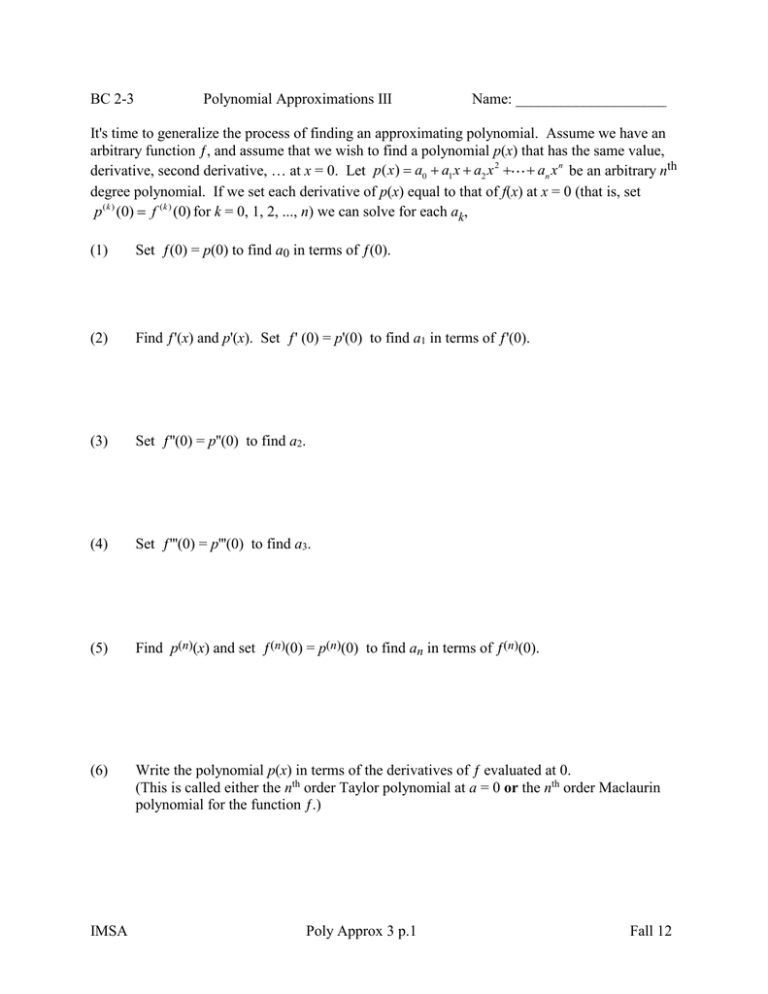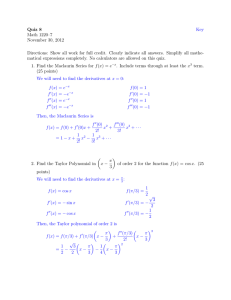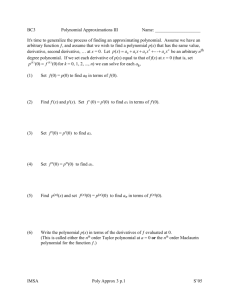Poly Approx III
advertisement

BC 2-3 Polynomial Approximations III Name: ____________________ It's time to generalize the process of finding an approximating polynomial. Assume we have an arbitrary function ƒ, and assume that we wish to find a polynomial p(x) that has the same value, derivative, second derivative, … at x = 0. Let p( x) a0 a1 x a2 x 2 an x n be an arbitrary nth degree polynomial. If we set each derivative of p(x) equal to that of f(x) at x = 0 (that is, set p( k ) (0) f ( k ) (0) for k = 0, 1, 2, ..., n) we can solve for each ak, (1) Set ƒ(0) = p(0) to find a0 in terms of ƒ(0). (2) Find ƒ'(x) and p'(x). Set ƒ' (0) = p'(0) to find a1 in terms of ƒ'(0). (3) Set ƒ''(0) = p''(0) to find a2. (4) Set ƒ'''(0) = p'''(0) to find a3. (5) Find p(n)(x) and set ƒ(n)(0) = p(n)(0) to find an in terms of ƒ(n)(0). (6) Write the polynomial p(x) in terms of the derivatives of ƒ evaluated at 0. (This is called either the nth order Taylor polynomial at a = 0 or the nth order Maclaurin polynomial for the function ƒ.) IMSA Poly Approx 3 p.1 Fall 12 What’s so special about matching all out derivatives at x = 0? What if we wanted to (or had to— consider f(x) = ln x) match our derivatives at some other x? The thing that made x = 0 easy was that when we plugged in 0 into a polynomial, all the terms except the constant go away. But if we write p( x) a0 a1 ( x x0 ) a2 ( x x0 ) 2 an ( x x0 ) n we could plug in x = x0 and have everything cancel out. Definition: Suppose that the first n derivatives of f(x) all exist at x = x0. The nth-order Taylor polynomial at x = x0 is defined as f ( x0 ) f ( x0 ) f ( n ) ( x0 ) 2 3 pn ( x) f ( x0 ) f ( x0 )( x x0 ) ( x x0 ) ( x x0 ) ( x x0 ) n 2 6 n! Note: In the special case that x0 = 0, this polynomial is called the nth-order Maclaurin polynomial. (7) Verify that pn(x), its first four derivatives, and its nth derivative match those of f(x) when x = x0. (8) Use the definition to find the following Taylor polynomials: (a) f ( x) cosh x, x0 0, n 4 (b) f ( x) sin x, x0 0, n 4 (c) f ( x) e x , x0 0, n 4 (d) f ( x) ln x, x0 1, n 4 IMSA Poly Approx 3 p.2 Fall 12 (9) Use the definition to find the 10th degree Maclaurin polynomial for f ( x) e x . (10) Find the 10th degree Maclaurin polynomial for f ( x) e x . (11) Find the 10th degree Maclaurin polynomial for f ( x) cosh x . (12) Be prepared to say something intelligent about the previous three problems when the Honorable Herr Doktor Doktor Professor Condie asks. IMSA Poly Approx 3 p.3 Fall 12





